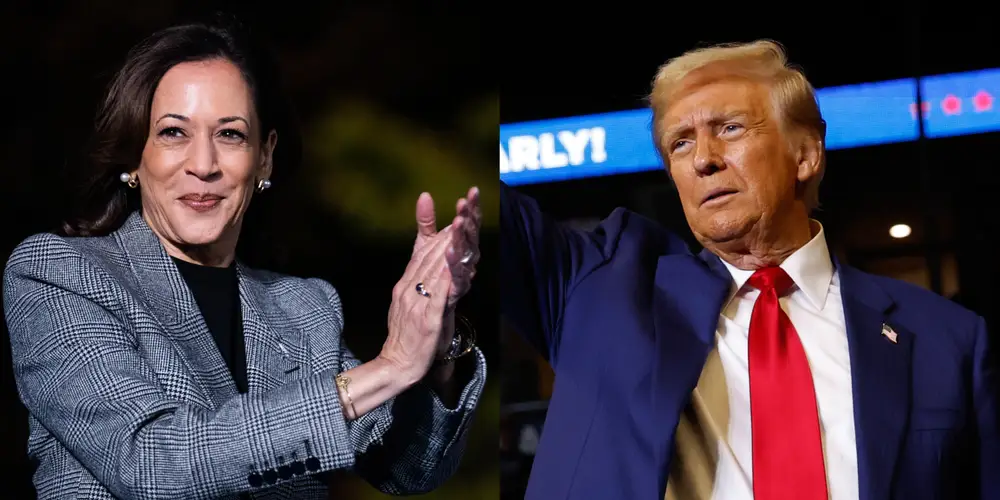The US presidential election is 2 days away. Here’s where things stand.

Election Day is almost upon us.
With Election Day on Tuesday, the end is in sight for what has been a contentious US presidential race between Vice President Kamala Harris and former President Donald Trump.
More than 68 million Americans have already cast their ballots, a stunning figure that demonstrates the high interest and high stakes in a contest that has had more twists and turns than any presidential contest in recent memory.
Throughout the campaign, Trump has benefited from unease over the economy, a consistently top issue for voters. When President Joe Biden was the presumptive Democratic nominee, it was his biggest vulnerability, despite low unemployment and consistent job gains after the height of the COVID-19 pandemic.
Inflation has been driving much of the voter anxiety about the economy. Although wages have increased in recent years, higher prices have affected the finances of millions.
After Biden stepped aside as the nominee in July and Harris became the Democratic Party standard bearer, she immediately focused on the issue, vowing to attack price gouging and unveiling a broad economic plan of her own.
It wasn’t long before Harris began to narrow the gap between the Democrats and the GOP in the presidential race.
Now, in its final days, the race remains tight, with both candidates virtually tied in the swing states as they make their last appeals to voters.
The battleground states remain close
Harris’ clearest path to reach 270 electoral votes — and an overall victory — is to sweep every Democratic stronghold and blue-leaning state while also winning Michigan, Pennsylvania, Wisconsin, and Nebraska’s 2nd Congressional District.

Vice President Kamala Harris has been a frequent presence in Michigan, a state critical to her electoral path.
Michigan, Pennsylvania, and Wisconsin form a critical core of the “blue wall” of states that backed Democratic presidential nominees from 1992 until 2012, but have more recently been less reliable for Democrats.
The three states — which both Harris and Trump have crisscrossed in their hunt for votes — contain urban, suburban, and rural areas that will be key for each candidate in the race.
(Pennsylvania offers 19 electoral votes, while Michigan has 15, and Wisconsin has 10. Nebraska’s 2nd offers one vote, which could be decisive for Harris.)
In 2016, Trump breached the blue wall, winning all three states by making inroads with working-class voters that had previously supported former President Barack Obama, including a critical bloc of independents and union workers.
But in 2020, Biden flipped the blue wall states back into the Democratic column, but only narrowly. That year, Biden also won Nebraska’s Omaha-anchored 2nd District, and recent polling suggests that Harris may, in fact, also hold an advantage there.
Harris has directed much of her energy on these states, where she’ll need to perform well to counter Trump’s stronger standing in the Sun Belt.
The Sun Belt states
Trump appeared favored to win Arizona, Georgia, Nevada, and North Carolina when he was running against Biden. But Harris’ candidacy activated young and minority voters who were unenthusiastic about Biden, allowing her to broaden the Democratic map.
As a result, the Sun Belt states remain competitive. Republicans appear to have built an early-vote advantage in Nevada. However, Election Day turnout and the direction of the remaining mail-in ballots remain anyone’s guess.
Voters in the Sun Belt have been focused on the economy and immigration, two issues that benefit Trump. But Harris has managed to cut into Trump’s edge on economic issues while also polling strongly on issues like abortion, democracy, and supporting the middle class.
We could see a historic gender gap
Shortly before Biden left the race, he held a small advantage with women, while Trump fared much better with male voters.
However, with Harris as the Democratic nominee — and the potential for the United States to elect its first-ever female president — the country will likely see a historically large gender gap once all the votes are counted.

Former President Donald Trump has a wide advantage with male voters.
Harris’ robust female stems, in part, from abortion rights.
The Supreme Court in 2022 overturned Roe v. Wade, sending the issue of abortion back to the states. Now, millions of women live in states with near-total abortion bans, while millions of other women live in states where abortion rights have been strengthened.
In the closing days of the race, Harris has heavily emphasized the issue, which also helped Democrats in the 2022 midterms.
Meanwhile, Trump has appeared on podcasts that appeal to conservative-leaning male listeners and seems to have attracted some significant support from young Black and Latino men, according to polling.
The huge gender gap is illustrated in a recent top-rated national poll.
A late October New York Times/Siena College survey of likely voters showed Trump ahead of Harris by 14 points among men (55% to 41%), while Harris held a 12-point edge over Trump (54% to 42%) with women. Overall, the survey showed the race tied, with the candidates each earning 48% support from respondents.






